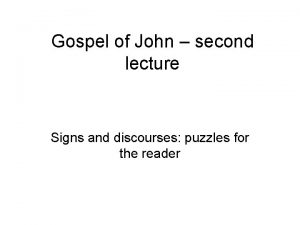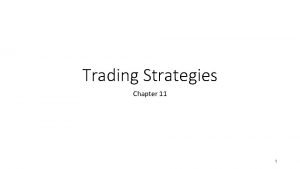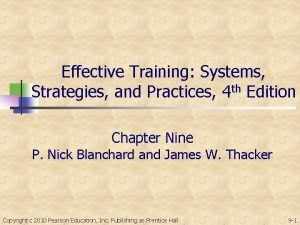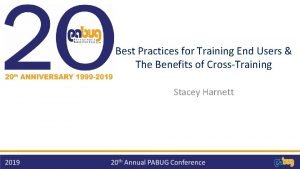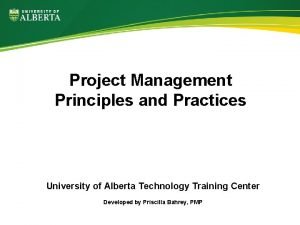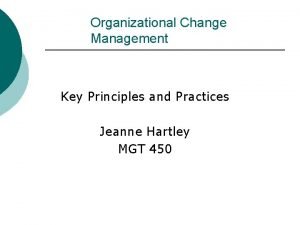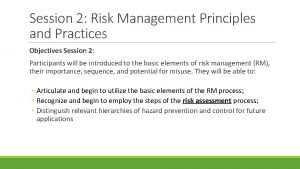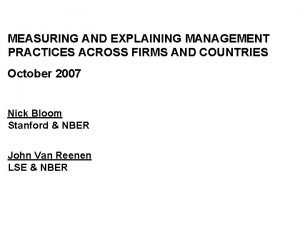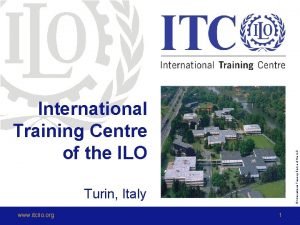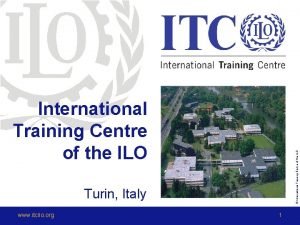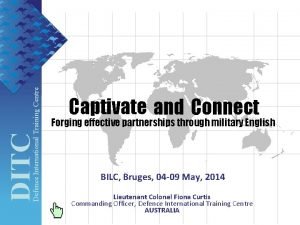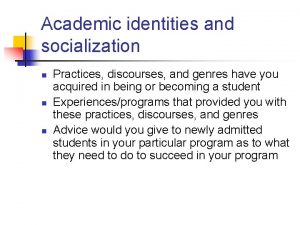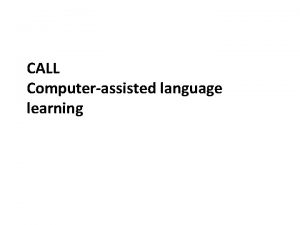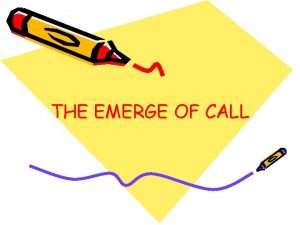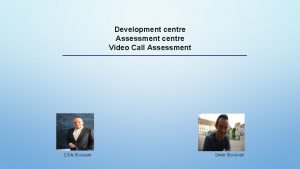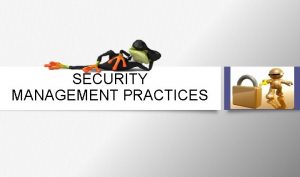Training Practices and Discourses in Call Centre Management

























- Slides: 25

Training Practices and Discourses in Call Centre Management Points of Consideration for Managers Magda Fusaro & Isabelle Moncion Université du Québec à Montréal 3 mai 2010 Talk given as part of the Managing by Values Beyond Cultures and Generations Mac. Ewan School of Business 2 nd International Business Conference

Presentation plan A performance analysis: the Bell Mobility marketing call centre A study on the phenomenon of impatience (as an emotion, a feeling, a constraint) at the Megantic call centre Success factors: best practices for recruitment, training and improving customer relations This creation is under a contract Creative Commons

1 - Study on client relations management Study 1 : Bell Mobility call centre (blended) Inbound calls (20%) and outbound calls (80%) Increased competition led to slower growth Restructuration due to the introduction of new IT systems (IS) Introduction of single-bill system New cross-product sales (internet, landline, mobility, etc. ) Difficulty obtaining information in time for the various programs Performance analysis of the call centre This creation is under a contract Creative Commons

1. 1 - Performance according to Bell Mobility: a typical case An analysis of the technological tools while considering organizational changes (restructuration) A performance analysis of the centre – both managers and agents A study of the impact of change on the agents’ level of satisfaction This creation is under a contract Creative Commons

1. 2 - Telemarketing: une « Bell » image Well managed centre that satisfies its sales objectives Agents that work in a friendly, dynamic, stimulating environment that relies on a decentralized hierarchy But problems with retention and training Considerable control mechanisms (systems such as the dialer) Agents were experiencing decrease in performance and motivation This creation is under a contract Creative Commons

2 - Study on client relation managment Study 2 : « Mégantic » call centre Inbound calls only Restructuration due to new IT systems and new online services Considerable wait time for clients Complex services and products (cases dealing with death, international issues, etc. ) Frequently changing information Analyzing the centre’s performance through the phenomenon of impatience This creation is under a contract Creative Commons

2. 1 - Humanize client relations Well managed center aiming to humanize client relations Increasing complexity of IT tools: where to locate the information (wait time for clients) Agents experiencing difficulty « organization's image » representing the Feeling of isolation: each agent works in a « bubble » This creation is under a contract Creative Commons

3 - Research objectives Understand what a « client relations » culture implies (Licoppe, 2003) Identify indicators of satisfaction and dissatisfaction (agents and clients) Promote a sense of belonging within the organization Focus on team work and training and information This creation is under a contract Creative Commons

3. 1 - Questions To what extent to statistical indicators (sales stats) lead to an accurate performance evaluation? To what extent do initial training and ad hoc training lead to performance objectives? How can employee involvement be encouraged? How can information circulation be optimized? This creation is under a contract Creative Commons

3. 2 - Questions (con’t) What are the causes of impatience? What are the impacts of impatience on callers? What are the attitudes that can be adopted by agents to counter impatience and mitigate its impact on client relationship? This creation is under a contract Creative Commons

4 - Originality of methodology Call centres deal with inbound and outbound calls Most studies aim to quantify such activities We took a qualitative approach: participant observation Listening-in on calls Interviews with agents and managers Focus groups for retroaction This creation is under a contract Creative Commons

4 - Participant observation Laperrière (2006) states that participant observation is an approach with « objectives that surpass simply describing the components of a social situation and insists on the importance of seeking its meaning, orientation and dynamics » 3 hours of observation per agent 30 1 -hour interviews with each agent 100 hours of listening-in 5 focus groups Data analysis with Nvivo (8) program for both text and audio files This creation is under a contract Creative Commons

5 - Establishing a client-based culture Being aware of client satisfaction (or dissatisfaction) Improving service quality Placing the needs of the client at the centre of operations and limiting communication breakdowns Placing the client at the centre of marketing strategies, to ensure satisfaction and loyalty « The client is at the heart of organizations and client contact centers are the first step in the development of this relationship (Simard, 2002). » This creation is under a contract Creative Commons

6 - What determins satisfaction Feinberg, Kim, Hokama, de Ruyter et Keen, (2000) Wait time Business hours of the call centre Number of agents to go through before getting an answer Organization of calls in cue Level of satisfaction with previous calls Rate of abandoned calls by the caller Length of calls with agent Extra research needed to complete the information received Service customization Call system’s level of complexity This creation is under a contract Creative Commons

6 - What determins satisfaction (con’t) According to the Centre d'expertise des grands organismes (GECO, 2006) satisfaction factors are linked to 1) wait time et 2) agents attitudes. Capacity to speak directly with a person, as fast as possible; Agents’ personal or learnt qualities – professional, polite, knowledgeable, respectful, patient, articulated; Way in which the transaction is handled, including responsibility, preciseness of information and timeliness. This creation is under a contract Creative Commons

6. 1 - The impact of impatience What is it? Dissatisfaction? Frustration? Anger? Annoyance? Impatience on the callers’ part is directly linked to their satisfaction (Dano, Llosa et Orshinger 2003) Satisfaction is linked to service quality and agents’ attitudes, and client behavior Two interrelated notions: to what extent does impatience become a determining factor in the success of sale or service ? This creation is under a contract Creative Commons

6. 2 - Satisfaction-Impatience relationship Measuring the level of satisfaction according to the attitude of the caller, and the caller’s evaluation of the service: « Alain (2002) demonstrated that the absence of certain factors (such as courtesy) could lead to dissatisfaction but at the same time, their presence didn’t necessarily ensure greater satisfaction » Wait time remains the most important irritant for call centre clients (Bennington, Cummane et Conn, 2000). These variables are linked to impatience (Davis et Heineke 1998). This creation is under a contract Creative Commons

6. 3 - Variables to consider Unoccupied time feels longer than occupied time Pre-process waits feel longer than in-process waits Anxiety makes waits seem longer Uncertain waits are longer than know finite waits Unexplained waits are longer than explained waits Unfair waits are longer than equitable waits The more valuable the service the longer the customise will wait Waiting alone feels longer than when waiting with a group Maister 1985, Davis et Heineke 1998, Zohar et Mandelbaum et Shimkin 2002, Tom et Burns et Zeng 1997 This creation is under a contract Creative Commons

6. 3 - Variables to considers (con’t) Motivation Mood Social status (Zohar, Mandelbaum et Shimkin 2002) Callers’ ages Previous experience with call centres This creation is under a contract Creative Commons

7 - Sense of belonging Supervisor attentiveness An environment centered around client satisfaction and high quality service Identifying methods for recognition of employees (agents) Providing for the involvement and participation of agents (Meyssonnier, 2003) Focusing on non-material factors (organizational values, personal relationships, etc. (Ibidem). This creation is under a contract Creative Commons

8 - Training and information: selfevaluation Close relationship between the level of performance and the level of training Frequent technological changes requires agents to be flexible Ensuring accuracy of information while maintaining quick response time Overabundance of information leading to unnecessary or inapplicable information for clients Team work a part of feedback and retroaction This creation is under a contract Creative Commons

9 - Team work Peer accompaniment was one of the most interesting observations during these studies Knowledge sharing between agents increases savoir -faire Working on issues as a group developps a sense of belonging while providing a space for problem solving Reinforces agents’ sense of control over their work and their level of satisfaction at work This creation is under a contract Creative Commons

10 - Points of consideration … Shorter training sessions, but more frequently Manager attentiveness: planned meetings Team work : problem solving by the agents Putting together « creative hubs » to break up the routine Providing agents with the capacity to give more time to clients This creation is under a contract Creative Commons

10 - … all things considered Increasing angent responsibility and independance within a framework acceptable for agents and managers Self-evaluation, self-control when there is a participatory culture within the organisation Promoting creativity without creating unrealistic expectations Anticipating change resistance through Lead User (Von Hippel) This creation is under a contract Creative Commons

Questions Merci de votre attention! This creation is under a contract Creative Commons
 Call centre management training
Call centre management training Discourse example sentence
Discourse example sentence New discourses
New discourses 7 discourses in john
7 discourses in john If your right hand offends you
If your right hand offends you Statics
Statics Centroids and center of gravity
Centroids and center of gravity Protective put diagram
Protective put diagram Option a option b
Option a option b +call +recording +call +centers +gartner
+call +recording +call +centers +gartner Effective training systems strategies and practices
Effective training systems strategies and practices Ncsct smoking cessation
Ncsct smoking cessation End user training best practices
End user training best practices Project management principles and practices
Project management principles and practices Project management principles and practices
Project management principles and practices Change management principles and practices
Change management principles and practices Safety practices and sports injury management pictures
Safety practices and sports injury management pictures Risk management principles and practices
Risk management principles and practices Management practices across firms and countries
Management practices across firms and countries International training centre of the ilo torino
International training centre of the ilo torino Oit turin
Oit turin Highveld training centre
Highveld training centre Adfelps test online
Adfelps test online Gmmco training centre
Gmmco training centre Edip army
Edip army Bedfordshire gcse maths
Bedfordshire gcse maths



